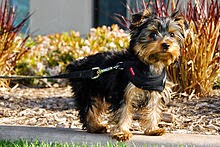This breed originated in Yorkshire (and adjoining Lancashire), a rugged region in northern England. In the mid-19th century, workers from Scotland came to Yorkshire in search of work and brought with them several defferent varieties of small terriers. Breeding of the Yorkshire terrier was "principally accomplished by the people - mostly operatives in the woollen mills - in the counties of Yorkshire and Lancashire. Details are scarce. **Mrs M A Foster is quoted as saying in 1886 "If we consider that the mill operatives who originated the breed.....were nearly all ignorant men, unaccustomed to imparting information for public use, we may see some reason why reliable facts have not been easily obtained.
In the early days of the breed, "almost anything in the shape of a Terrier having a long coaat with blue on the body and fawn or silver coloured head and legs, with tail docked and ears trimmed, was received and admired as a Yorkshire Terrier", but in the late 1860s, a poplar Paisley type Yorkshire Terrier show dog named Huddersfield Ben, owned by a woman living in Yorkshire, **Mary Ann Foster, was seen at dog shows throughout Great Britain, and he defined the breed type for the Yorkshire Terrier.
Huddersfield Ben was a famous dog. His portrait was painted by George Earl and in 1891 an authority on the breed wrote "Huddersfield Ben was the best stud dog of his breed during his lifetime, and one of the most remarkable dogs of any pet breed that ever lived, and most of the show specimens of the present day have one or more crosses of his blood in their pedigree." A show winner, Huddersfield Ben quickly became the type of dog everyone wanted, and through his puppies has defined the breed as we know it today. He is still referred to as "the father of the breed".
Yorkshire Terriers - Mrs Foster's "Huddersfield Ben" and Lady Giffard's "Katie" ca1870.
The Yorkshire Terrier was introduced in North America in 1872 and the first Yorkshire Terrier was registered with the American Kennel Club (AKC) in 1885. During the Victorian era, the Yorkshire Terrier was a popular pet and show dog in England, and as Americans embraced Victorian customs. so too did they embrace the Yorkshire Terrier. The breed's popularity dipped in the 1940s, when the percentage of small breed dogs fell to an all-time low of 18% of total registrations. Smoky, a Yorkshire Terrier and a famous was dog from World War 2, is credited with beginning a renewal of interest in the breed.
All the above information and pictures courtesy of Wikipedia.





They do have a lovely face - but not for me.
ReplyDeleteMy sentiments exactly.
DeleteI like the look of well cared for Yorkies and Silkies, bright eyed, shiny brushed coats, but I wouldn't have one. I knew a Silky once, named Ruffy, he had only three legs after being hit by a car, but that didn't slow him down one bit.
ReplyDeleteYes, to your comment.
DeleteI also knew a silky called 'Scruffy' who would be seen sometimes a few miles from his home. He was a real traveller.
I like the short haired version.
ReplyDeleteThat's a good point....I don't like the 'show' type dogs.
DeleteHari OM
ReplyDeletethe original 'chamber' dog... to cute to avoid, to yappy to desire. For me anyway. Known a few over the years. Definitely owner-only critters!
Now the question is.... are there any Big Dogs like Big Cats?? Well unless the wolf, dingo, coyote, painted dogs, INDogs are counted... I guess there is whole other A-Z coming here??? I enjoy your researches Mimsie. Here's hoping! YAM xx
Definitely an owner-only dog in many ways I would think.
DeleteHave been thinking about what to do on Sundays in future. The big cats are not going to be A-Z but your suggestion re canine type animals is a good one. Thanks Yam, will look into that idea. I've done wildflowers of Australia and towns too so scratching my head right now.